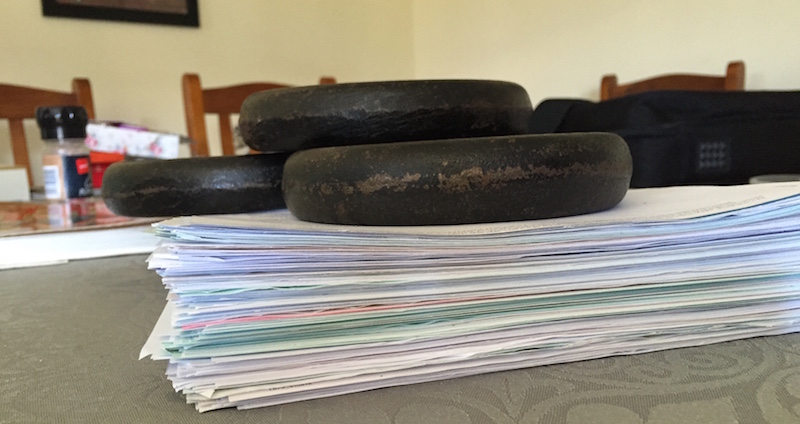The New Year period always prompts me to look for improvements I could make in my life. After some searching, I came across this article "Three Steps Toward a Paperless Culture". A quick glance at my immediate surroundings confirmed that becoming paperless would be a great improvement for my lifestyle. Imagine all those paper records gone!
In New Zealand, there are laws requiring you to keep business related records for at least seven years. Potentially this could become an insurmountable mountain of paper - a nightmare to sort, store and retrieve.

(A very small sample shown above, trying to flatten with weights...)
My scripting mind immediately took control seeking a solution to this problem. Assuming I had a folder full of scanned documents, how hard would it be to sort them?
As it turns out, very easy.
Tesseract
Tesseract is my OCR library of choice. Originally developed by HP, Tesseract was later improved and maintained by Google.
tesseract-ocr is a .NET wrapper for Tesseract by Charles Weld. We will be using this library with PowerShell to perform our OCR tasks.
Environment
If you want to proceed through this step quickly, I would suggest downloading and running the Initialize-Environment.ps1 script from my GitHub repo.
If you prefer to set everything up manually, create the following directory structure:
{Base Directory} /
-Input/
-Lib/
-tessdata/
-x86/
-x64/
-Output/
You will need to download the tesseract nuget package and copy the files to your Lib folder. Then download the Tesseract libraries and grab just the tessdata folder in the language of your choice (I chose English). Place this folder also into the Lib directory.
Reading text from an image
Reading text from an image is as simple as loading an image, passing it to Tesseract and receiving the output. For example:
#Import System.Drawing and Tesseract libraries
Add-Type -AssemblyName "System.Drawing"
Add-Type -Path ".\Lib\Tesseract.dll"
#Create tesseract object, specify tessdata location and language
$tesseract = New-Object Tesseract.TesseractEngine((Get-Item ".\Lib\tessdata").FullName, "eng", [Tesseract.EngineMode]::Default, $null)
#Load and process image
$image = New-Object System.Drawing.Bitmap("test.jpg")
$pix = [Tesseract.PixConverter]::ToPix($image)
$page = $tesseract.Process($pix)
#Get text
$text = $page.GetText()
$confidence = $page.GetMeanConfidence()
#Cleanup
$image.Dispose()
$page.Dispose()
It's that easy. The crazy thing is, it will take me longer to scan all the papers than it will to have them sorted!
PowerShell module
I have put together a PowerShell module to make OCR in your scripts even easier:
Import-Module tesseractlib.psm1
$ocr = Get-TessTextFromImage -Path "C:\Temp\test.jpg"
$ocr.Confidence
$ocr.Text
You can pass in either a ```[System.Drawing.Image]``` object or a string path to the image. A more advanced example could look like the following:
Import-Module tesseractlib.psm1
$files = Get-ChildItem *.jpg | Get-TessTextFromImage
$files | Format-list
The module can be found in my [GitHub repo](https://github.com/jourdant/powershell-paperless/blob/master/tesseractlib.psm1").
Conclusion
It's really easy to read text from images in PowerShell.
If you are looking to add OCR to your WinRT app, I would recommend checking this post from Iris Classon. There's even a video to go with it!
I have to go now, my giant stack of paper awaits. Another post will follow with my progress using this module.
Jourdan